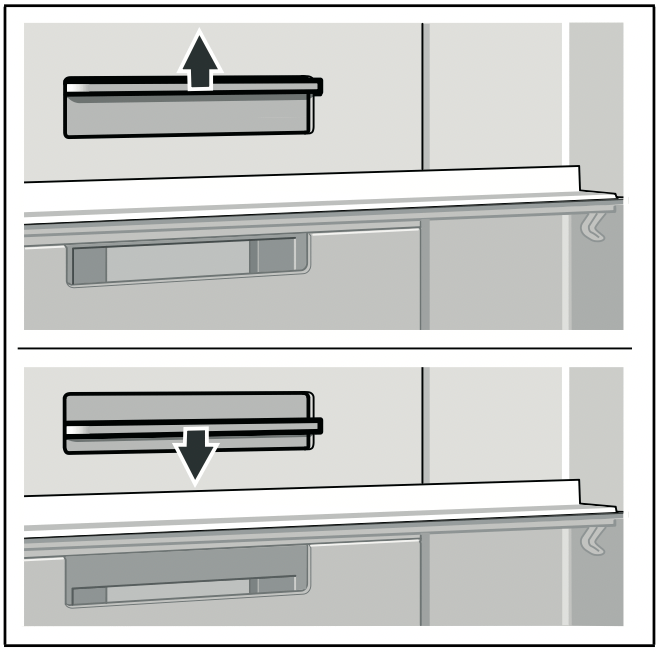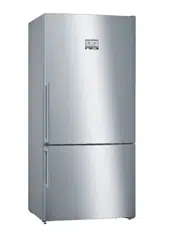Documents: Go to download!
User Manual
- User Manual - (English)
- Product spec sheet - (English)
- Datasheet - (English)
- Spec Sheet (web) - (English)
- Energy Label - (English)
- Installation Instruction - (English)
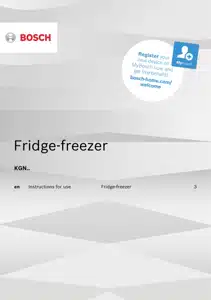
- Getting to know your appliance
- Operation Instruction
- Cleaning the appliance
- Eliminating minor faults yourself
Table of contents
User Guide Fridge freezer
Getting to know your appliance
Please fold out the illustrated last page. These operating instructions refer to several models.
The features of the models may vary. The diagrams may differ.
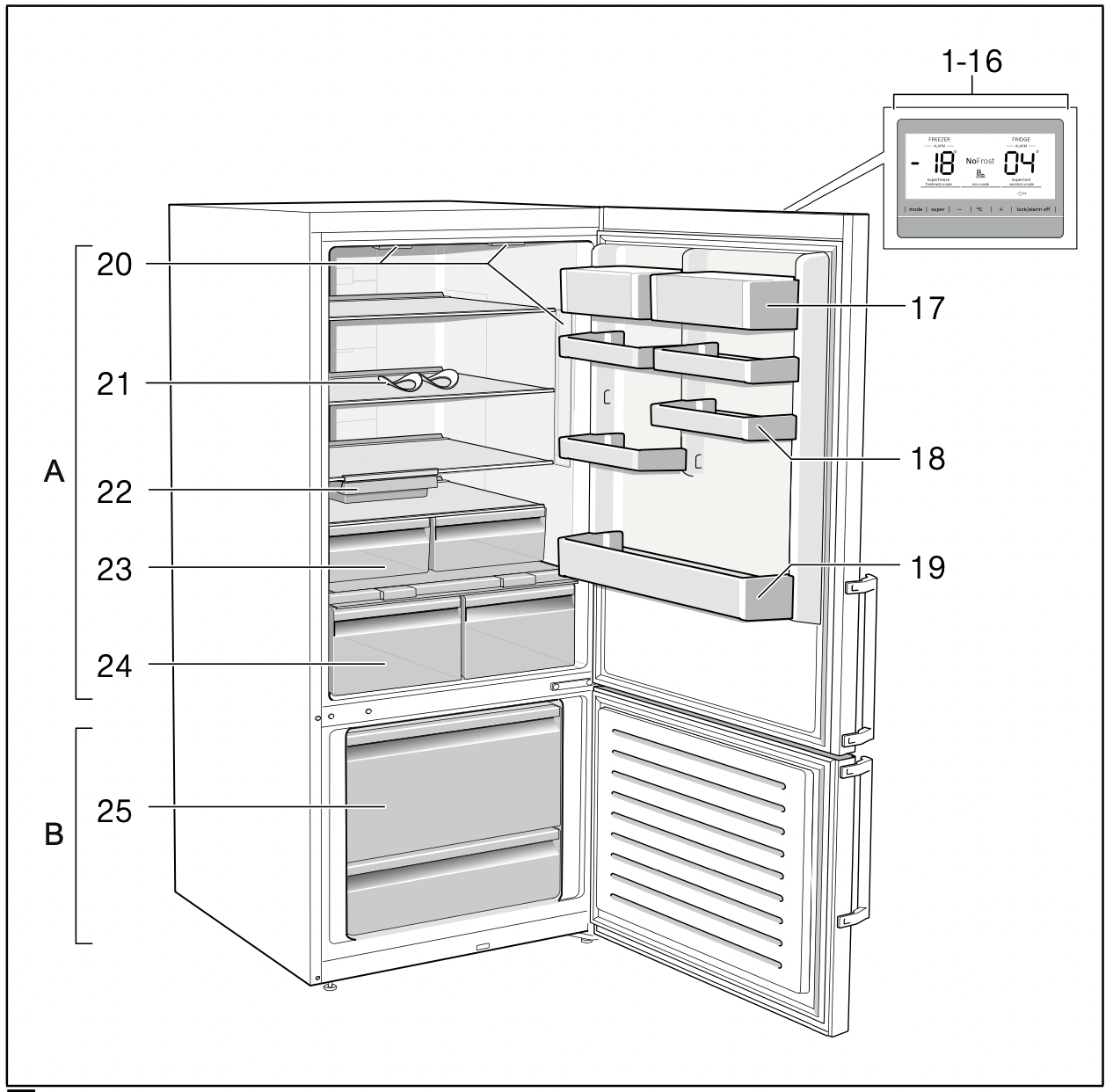
* Not all models.
A Refrigerator compartment
B Freezer compartment
1–16 Controls
17* Butter and cheese compartment
18* Shelf for small bottles
19 Shelf for large bottles
20 Light (LED)
21* Bottle shelf
22* Breakfast set
23 Cold storage compartment
24 Vegetable container with humidity control
25* Frozen food container
Controls
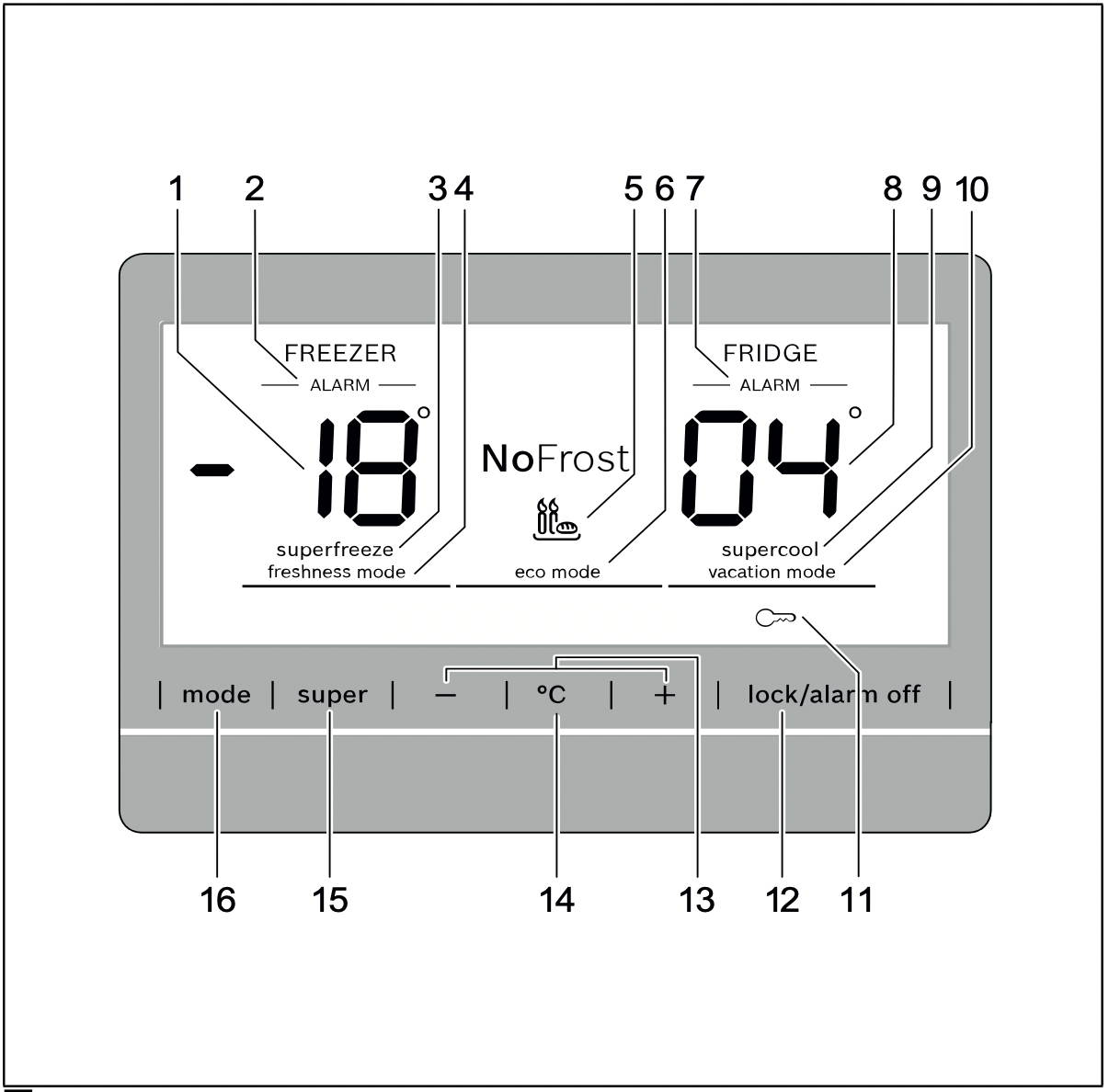
- Temperature display freezer compartment
The numbers correspond to the set freezer compartment temperatures in °C. - Display – ALARM
This lights up if the freezer compartment is too warm or if the freezer compartment door is open too long. - Display superfreeze
This lights up if super freezing is in operation. - Display freshness mode
This lights up when the freshness mode is switched on. - Display sabbath mode
This lights up when the sabbath mode is switched on. - Eco mode indicator
See other models: CTL636ES1 HGI12TQ59M HGK90VQ59M MCP3000GB MCP3000NGB
This lights up when the eco mode is switched on. - Alarm display
This lights up if the refrigerator compartment door is open too long. - Temperature display refrigerator compartment
The numbers correspond to the set refrigerator compartment temperatures in °C. - Display supercool
This lights up if super cooling is in operation. - Display vacation mode
This lights up when the vacation mode is switched on. - Button “lock” function
If this function is switched on, no settings are possible via the controls. - Button lock/alarm off
This button is used to
switch off the audible warning signal (see section "Alarm function")
switch the button lock on and off. - Setting buttons +/-
The buttons are used to set the temperatures of the refrigerator and freezer compartment. - °C button to select a section
Used to select a section. This is necessary to change its temperature or to switch on certain special functions. - Super button
Used to switch on the functions supercool (fridge compartment) and superfreeze (freezer compartment). - Button mode
Selecting the special functions.
Operation Instruction
Switching on the appliance
- First insert the plug into the connection on the back of the appliance. Check that the plug has been inserted all the way.
- Then insert the other end of the cable into the socket.
The appliance is now switched on and a warning signal sounds.
Press the lock/alarm off button to switch off the audible warning signal.
The – ALARM – display goes out when the appliance has reached the set temperature.
The preset temperatures are reached after several hours. Do not put any food in the appliance beforehand.
The factory has recommended the following temperatures:
- Freezer compartment: -18 °C
- Refrigerator compartment: +4 °C
Operating tips
- After the appliance has been switched on, it may take several hours until the set temperatures have been reached.
- The fully automatic NoFrost system ensures that the freezer section remains free of ice. Defrosting is no longer required.
- If the door cannot be immediately reopened after it has been closed, wait until the resulting low pressure has equalised.
- The front and side panels of the housing are partly heated slightly.This prevents condensation from forming.
Setting the temperature
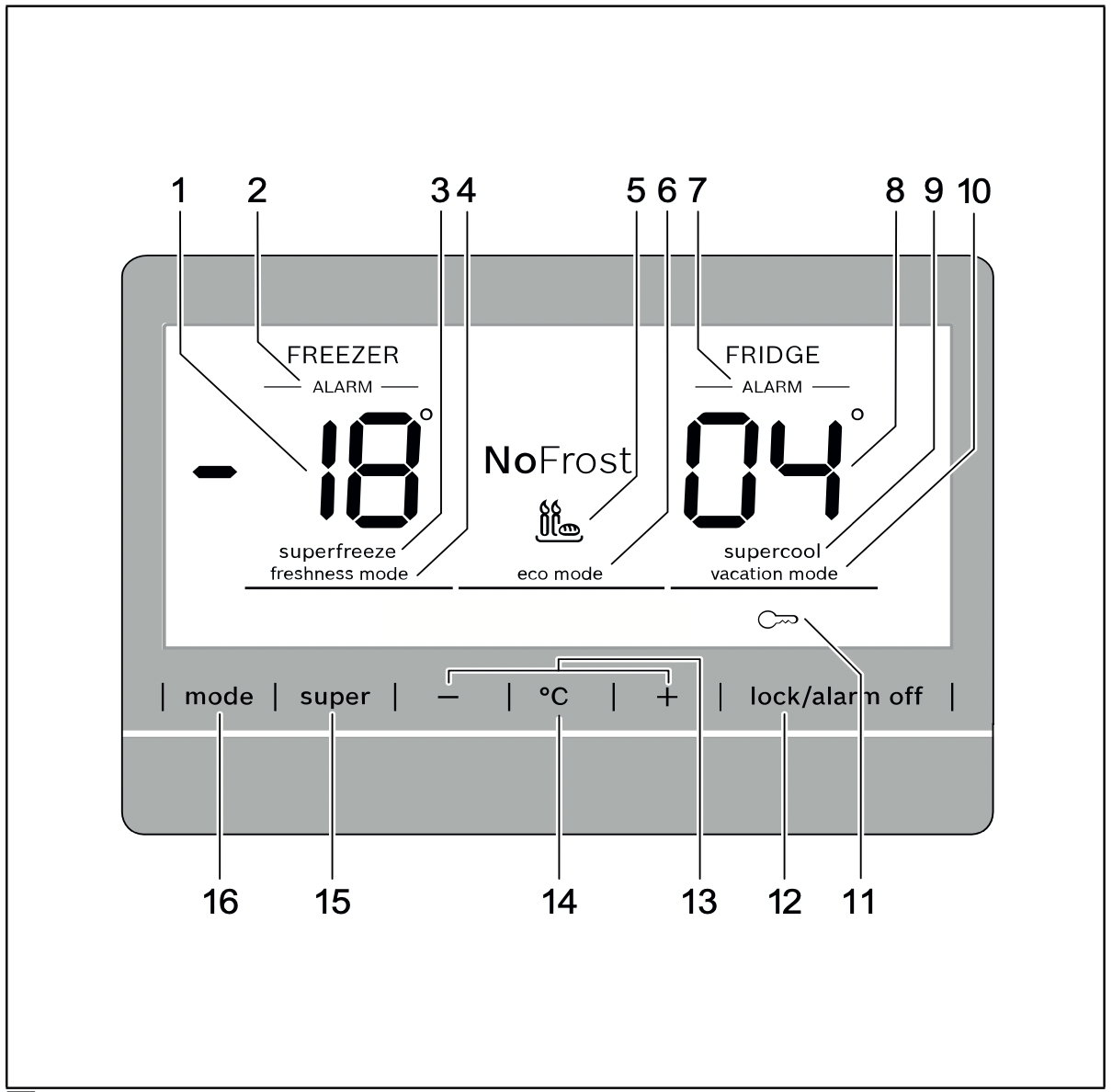
Refrigerator section
The temperature can be set from +2°C to +8°C.
- Select the refrigerator section using the °C button.
- Keep pressing the +/- buttons until the required temperature is indicated.
Perishable food should not be stored above +4 °C.
Freezer compartment
The temperature can be set from -16°C to -24°C.
- Select the freezer compartment using the °C button.
- Keep pressing the +/- buttons until the required temperature is indicated.
Special functions
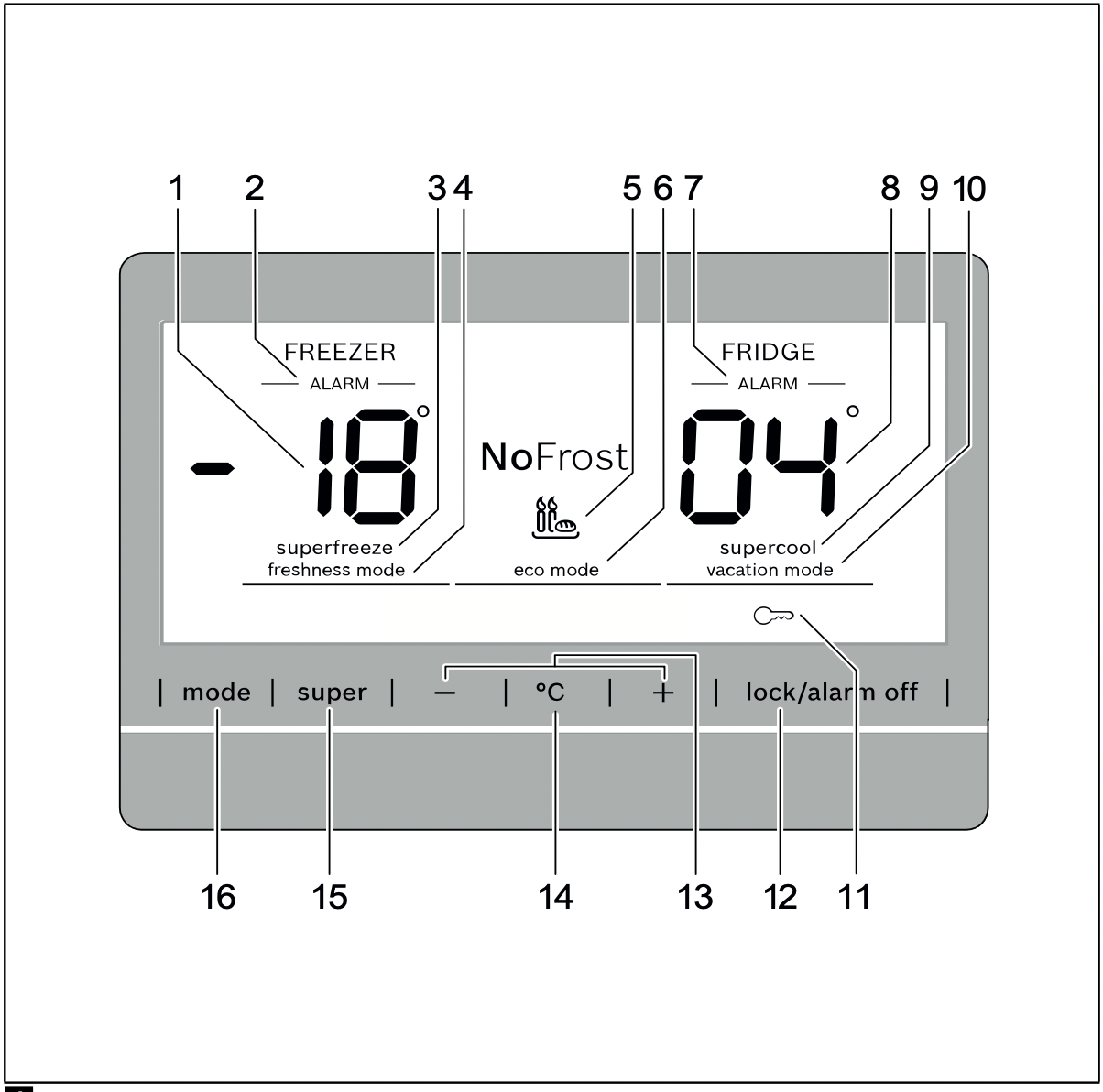
Fresh mode
Fresh mode gives food an even longer shelf life.
Switching on:
Press the mode button until the freshness mode display appears.
The appliance automatically sets the following temperatures:
- Refrigerator section: + 2°C
- Freezer section: remains unchanged
Switching off:
Press the mode button repeatedly until the freshness mode display goes off.
Eco mode
Eco mode switches the appliance to energy-saving operation.
Switching on:
Press the mode button until the "eco mode" indicator appears.
The appliance automatically sets the following temperatures:
- Refrigerator section: +8°C
- Freezer section: -16°C
Switching off:
Press the mode button until the "eco mode" indicator goes off.
Holiday mode
If leaving the appliance for a long period of time, you can switch the appliance over to the energy-saving holiday mode.
The temperature of the refrigerator compartment is automatically switched to +14 °C.
Do not store any food in the refrigerator compartment during this time.
Switching on:
Press the mode button repeatedly until the vacation mode display appears.
The appliance automatically sets the following temperatures:
- Refrigerator section: +14°C
- Freezer compartment: remains unchanged
Switching off:
Press themode button repeatedly until the vacation mode display goes off.
Button lock function
To switch the button lock on and off, press the lock/alarm off button for 5 seconds.
When the function is switched on, the  display lights up.
display lights up.
The control panel is now protected against unintentional operation.
Exception to the button lock:
The lock/alarm off button can be pressed to switch off the button lock or if an audible warning signal sounds.
Sabbath mode
When sabbath mode is switched on, the following settings are switched off:
- Audible signals
- Interior lighting
- Messages on the display panel
- The background illumination of the display panel is reduced
- Buttons are locked
Switching sabbath mode on and off: Press the super button for 15 seconds.
Alarm function
In the following cases an alarm may be actuated.
Door alarm
The door alarm switches on and ALARM – appears in the refrigerator compartment temperature display 8 or in the freezer compartment temperature display 1 if the door of the compartment is left open too long. Close the door of the compartment to switch off the door alarm.
Temperature alarm
The temperature alarm switches on if the appliance gets too hot inside and the food is at risk of thawing. An interval tone sounds and – ALARM – appears on the temperature display of the freezer compartment 1.
A temperature alarm may occur in these situations:
- Starting up the appliance for the first time
Do not store any food until the appliance has reached the set temperature. - Storing large quantities of fresh food in the appliance
Switch on super freezing before storing large quantities of fresh food. Avoid contact between fresh food and food that is already frozen. - Appliance door is open for a very long time
Check whether food has defrosted at all. Do not refreeze food after it has defrosted, even if just partially. - The appliance is being heated by a second refrigerator (side-by-side installation) or another heat source
Call customer service and ask them about ways of insulating your appliance.
Note: Do not refreeze thawing or thawed food. Only ready meals (boiled or fried) may be refrozen.
No longer store the frozen produce for the max. storage period.
The temperature display indicates for 5 seconds the warmest temperature which was reached in the freezer compartment. Then the set temperature is displayed again.
Switching off the alarm
Press the lock/alarm off button to switch off the audible warning signal.
Usable capacity
Information on the usable capacity can be found inside your appliance on the rating plate.
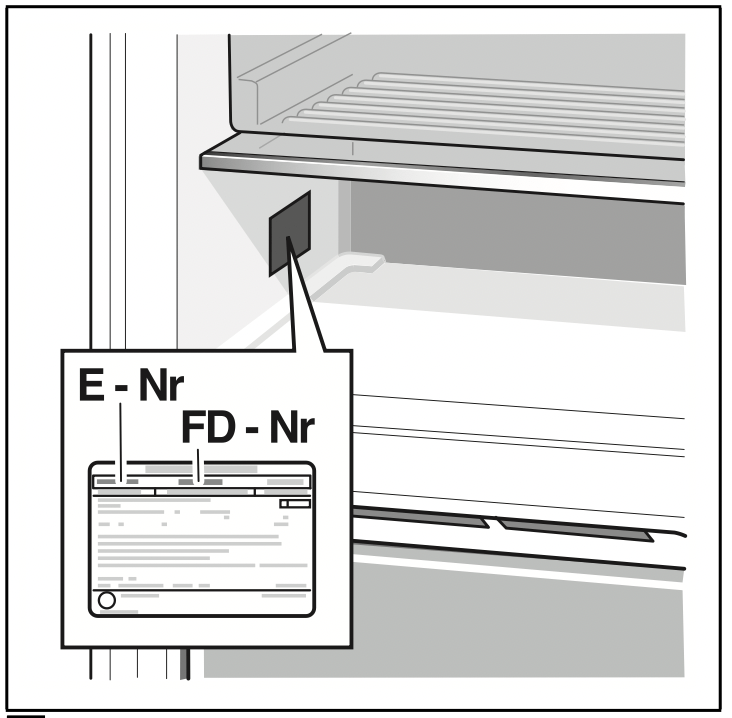
Fully utilising the freezer volume
To place the maximum amount of frozen food in the freezer compartment, you can remove the containers. You can then stack the food directly on the shelf and on the floor of the freezer compartment.
Note: Avoid contact between food and rear panel. Otherwise the air circulation will be impaired.
Food or packaging could freeze to the rear panel.
Removing the fittings
Pull out the frozen food container all the way, lift at the front and remove.
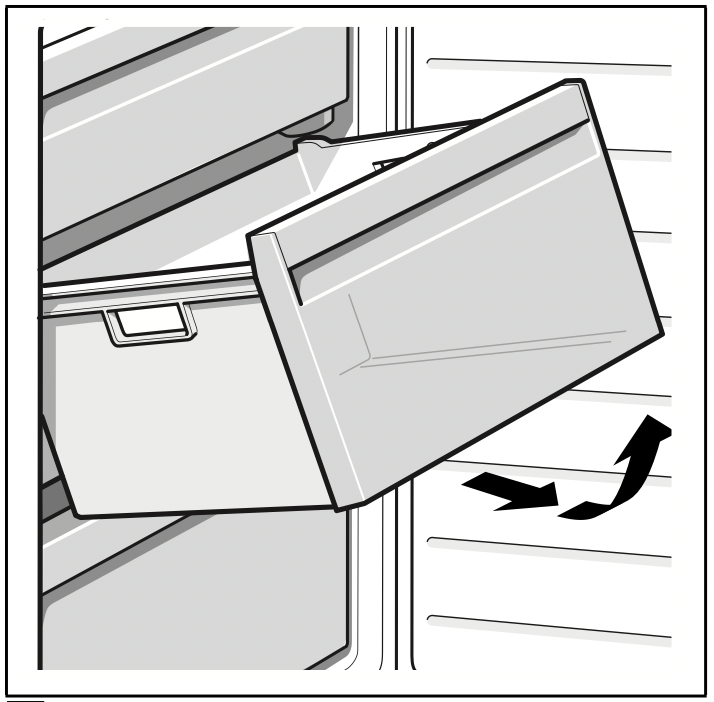
Refrigerator compartment
The refrigerator compartment is the ideal storage location for meat, sausage, fish, dairy products, eggs, ready meals and pastries.
Storing food
- Store fresh, undamaged food. The quality and freshness will then be retained for longer.
- In the case of ready-made products and bottled goods, observe the best-before date or use-by date specified by the manufacturer.
- To retain aroma, colour and freshness, pack or cover food well before placing in the appliance. This will prevent the transfer of flavours and the discolouration of plastic parts in the refrigerator compartment.
- Allow warm food and drinks to cool down before placing in the appliance.
Note: Do not block air outlet openings with food, otherwise the air circulation will be impaired. Food which is stored directly in front of the air outlet openings may be frozen by the cold air flowing out.
Note the chill zones in the refrigerator compartment
The air circulation in the refrigerator compartment creates different chill zones:
- The coldest zones are in front of the air outlet openings and in the chill compartment. (fig1/23)
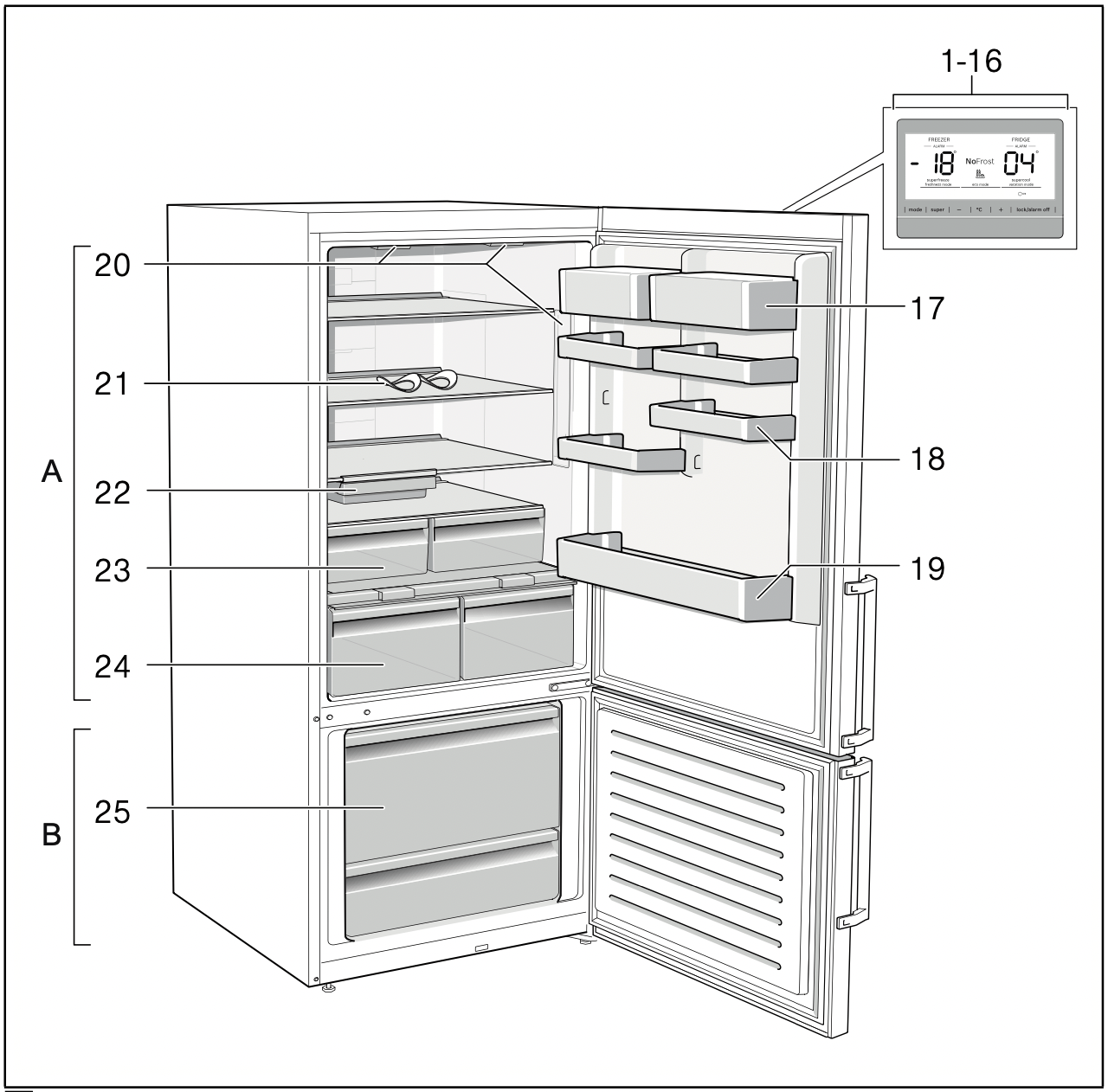
Note: Store perishable food (e.g. fish, sausage, meat) in the coldest zones. - Warmest zone is at the very top of the door.
Note: Store e.g. hard cheese and butter in the warmest zone. The aroma of hard cheese can then continue to develop and butter remains spreadable.
Vegetable container with humidity control
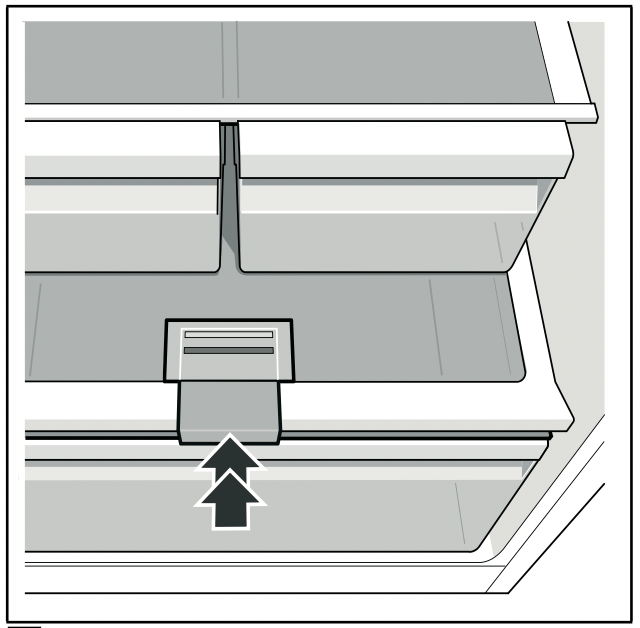
To create the optimum storage climate for fruit and vegetables, you can set the humidity level in the vegetable container:
- Mainly vegetables as well as for a mixed or small load – high air humidity
- Mainly fruit as well as for a large load – low air humidity
Notes
- Fruit sensitive to cold (e.g. pineapple, banana, papaya and citrus fruit) and vegetables sensitive to cold (e.g. aubergines, cucumbers, zucchini, peppers, tomatoes and potatoes) should be stored outside the refrigerator at temperatures of approx. +8 °C to +12 °C for optimum preservation of quality and flavour.
- Condensation may form in the vegetable container depending on the type and quantity of products stored. Remove condensation with a dry cloth and adjust air humidity in the vegetable container with the humidity controller.
Cold storage compartment
The cold storage compartment has lower temperatures than the refrigerator compartment. Even temperatures below 0 °C may occur.
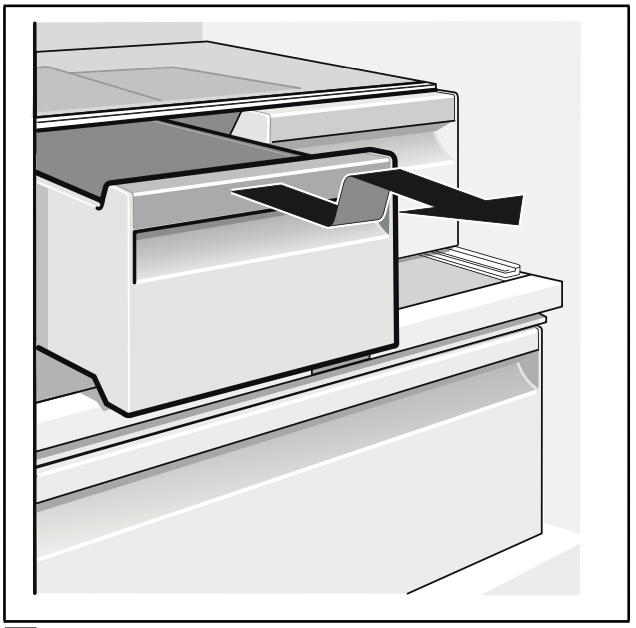
Ideal for storing fish, meat and sausage. Not suitable for lettuce and vegetables and produce sensitive to cold.
The temperature of the chill compartments can be varied using the ventilation opening. Push temperature controller upwards to reduce the temperature. Push temperature controller downwards to increase the temperature.
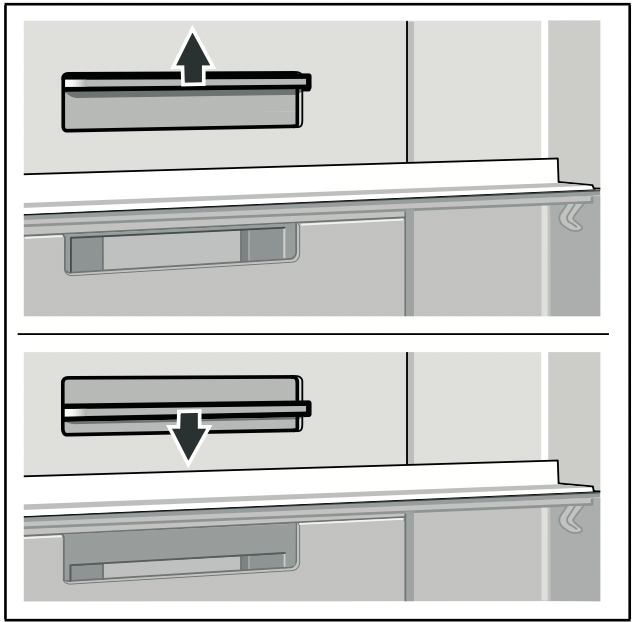
Super cooling
Super cooling sets the refrigerator temperature to the coldest temperature setting for approx. 6 hours. Then the appliance automatically switches to the temperature set prior to super cooling mode.
Switch on super cooling mode, e.g.
- before placing large quantities of food in the refrigerator compartment.
- for the fast cooling of drinks.
Switching on and off
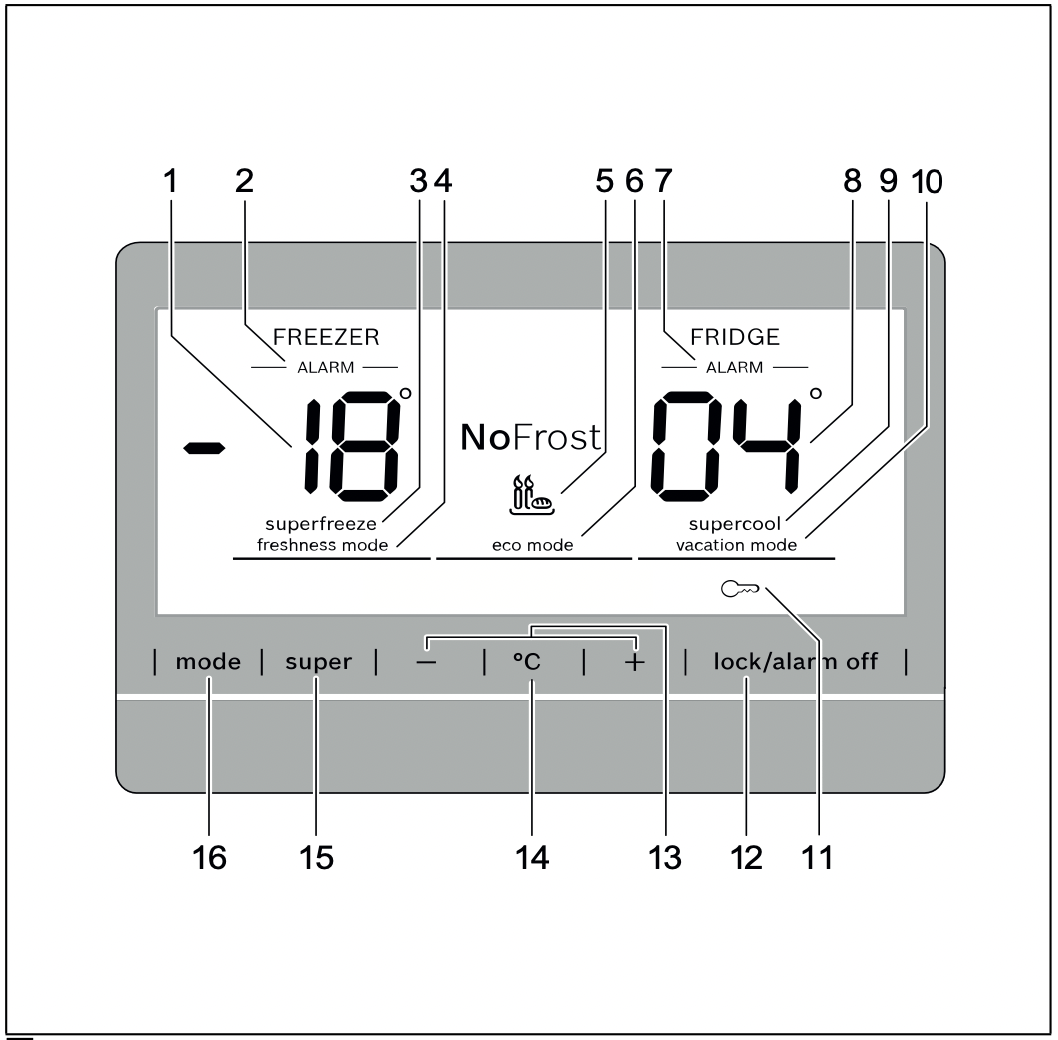
- Select the refrigerator section using the °C button.
- Press super button.
The supercool indicator lights up.
You do not need to switch off super cooling.After 6 hours the previously set temperature will be automatically restored.
Note: When super cooling is switched on, increased operating noises may occur.
Freezer compartment
Use the freezer compartment
- To store deep-frozen food.
- To make ice cubes.
- To freeze food.
Note: Ensure that the freezer compartment door has been closed properly. If the door is open, the frozen food will thaw. The freezer compartment will become covered in thick ice. Also: waste of energy due to high power consumption!
Freezing capacity
Information on the freezing capacity can be found on the rating plate.

Prerequisites for freezing capacity
- Switch on fast freezing 24 hours before placing fresh products in the compartment (see chapter “Fast freezing”).
- Preferably freeze large quantities of food in the bottom compartment. This is where food freezes particularly quickly and therefore also gently.
Freezing and storing food
Purchasing frozen food
- Packaging must not be damaged.
- Use by the “use by” date.
- Temperature in the supermarket freezer must be -18 °C or lower.
- If possible, transport deep-frozen food in an insulated bag and place quickly in the freezer compartment.
When loading products, please note:
- Freeze larger quantities of food preferably in the bottom frozen food container. This is where food freezes particularly quickly and therefore also gently.
- Distribute the food over the whole area of the compartments or the frozen food containers.
Note: Food which is already frozen must not come into contact with the food which is to be frozen. If necessary, re-stack frozen food in the frozen food containers. - To ensure air circulation in the appliance, push the frozen food container all the way in.
Storing frozen food
Insert frozen food container all the way to ensure unrestricted air circulation.
Freezing fresh food
Freeze fresh and undamaged food only.
To retain the best possible nutritional value, flavour and colour, vegetables should be blanched before freezing. Aubergines, peppers, zucchini and asparagus do not require blanching.
Literature on freezing and blanching can be found in bookshops.
Note: Keep food which is to be frozen away from food which is already frozen.
- The following foods are suitable for freezing:
Cakes and pastries, fish and seafood, meat, game, poultry, vegetables, fruit, herbs, eggs without shells, dairy products such as cheese, butter and quark, ready meals and leftovers such as soups, stews, cooked meat and fish, potato dishes, soufflés and desserts. - The following foods are not suitable for freezing:
Types of vegetables, which are usually consumed raw, such as lettuce or radishes, eggs in shells, grapes, whole apples, pears and peaches, hard-boiled eggs, yoghurt, soured milk, sour cream, crème fraiche and mayonnaise.
Packing frozen food
To prevent food from losing its flavour or drying out, place in airtight containers.
- Place food in packaging.
- Remove air.
- Seal the wrapping.
- Label packaging with contents and date of freezing.
Suitable packaging:
Cling wrap, tubular film made of polyethylene, aluminium foil, freezer containers.
These products are available from specialist outlets.
Unsuitable packaging:
Wrapping paper, greaseproof paper, cellophane, bin liners and used shopping bags.
Items suitable for sealing packaged food:
Rubber bands, plastic clips, string, coldresistant adhesive tape, etc.
Bags and tubular film made of polyethylene (PE) can be sealed with a film heat sealer.
Shelf life of frozen food
Storage duration depends on the type of food.
At a temperature of -18 °C:
- Fish, sausage, ready meals and cakes and pastries: up to 6 months
- Cheese, poultry and meat: up to 8 months
- Vegetables and fruit: up to 12 months
Super freezing
Food should be frozen solid as quickly as possible in order to retain vitamins, nutritional value, appearance and flavour.
The appliance runs constantly when super freezing has been switched on. The freezer compartment temperatures are much lower than in normal operation.
Several hours before placing fresh food in the freezer compartment, switch on super freezing to prevent an unwanted temperature rise.
If the freezing capacity according to the rating plate is to be used, switch on super freezing 24 hours before the fresh products are placed in the freezer compartment.
Smaller quantities of food (up to 2 kg) can be frozen without “super freezing”.
Note: When super freezing is switched on, increased operating noises may occur.
Switching on and off
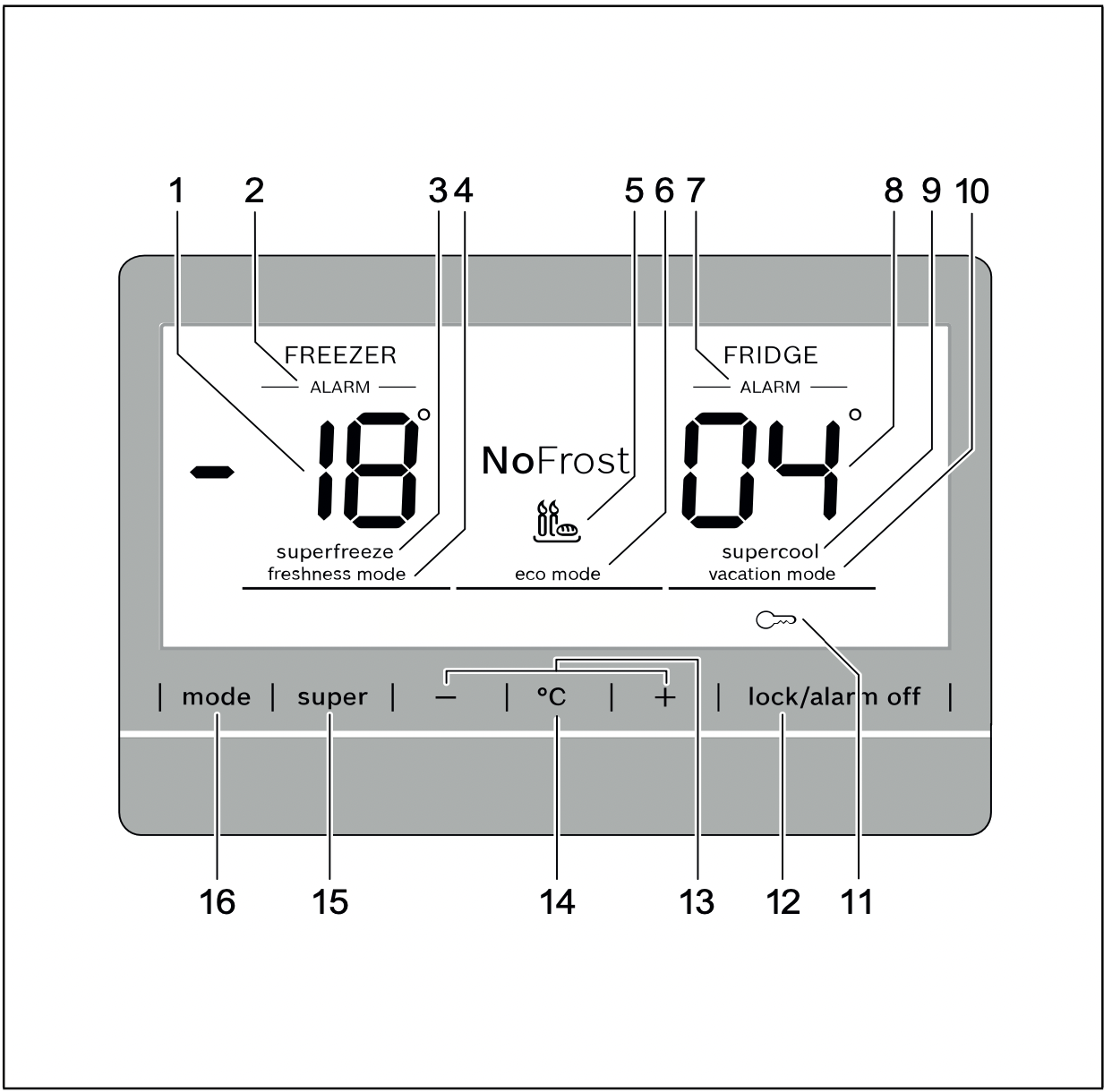
- Select the freezer section using the °C button.
- Press super button.
The superfreeze indicator lights up.
You do not need to switch off super freezing.After approx. 2½ days the previously set temperature will be automatically restored.
Thawing frozen food
Depending on the type and application, select one of the following options:
- at room temperature
- in the refrigerator
- in an electric oven, with/without fan assisted hot-air
- in the microwave
Caution
Do not refreeze thawing or thawed food. Only ready meals (boiled or fried) may be refrozen.
No longer store the frozen produce for the max. storage period.
Interior fittings
Shelves and containers
You can reposition the inner shelves and the containers in the door as required: pull shelf forwards, lower and swivel out to the side. Lift the container and remove.
Special features
(not all models)
Butter and cheese compartment
To open the butter compartment, gently press in the middle of the butter compartment flap.
To clean the compartment, lift it at the bottom and take out.
Breakfast set

The containers for the breakfast set can be taken out and filled individually.
You can take out the breakfast set for loading and unloading. To do this, lift the breakfast set and pull out. The container holder can be moved.
Bottle shelf
Bottles can be stored securely on the bottle shelf.
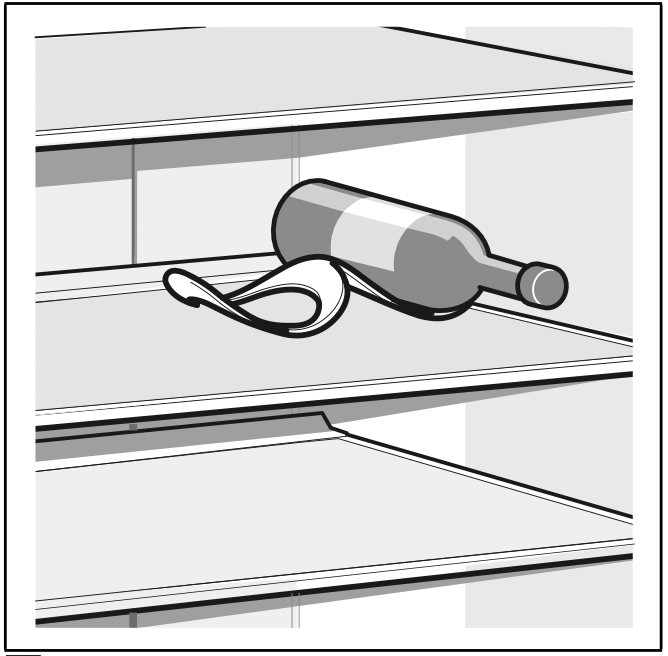
Ice cube tray

- Fill the ice cube tray ¾ full of drinking water and place in the freezer compartment.
- If the ice tray is stuck to the freezer compartment, loosen with a blunt implement only (spoon-handle).
- To loosen the ice cubes, twist the ice tray slightly or hold briefly under flowing water.
Freezer calendar
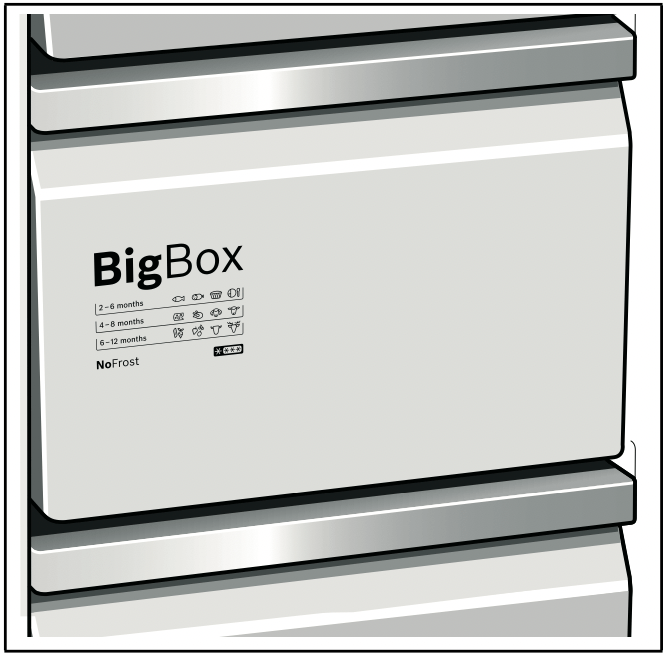
To prevent the quality of the frozen food from deteriorating, do not exceed the storage duration. The figures next to the symbols indicate the permitted storage period of the produce in months. In the case of commercially available frozen food observe the date of manufacture or use-by date.
Ice pack
The ice pack can be removed to cool food temporarily, e.g. in a cold bag.
If a power failure or malfunction occurs, the ice pack can be used to slow down the thawing process.
Sticker “OK”
(not all models)
The sticker “OK” lets you check whether the refrigerator compartment achieves the safe temperature ranges of +4 °C or colder recommended for food. If the sticker does not indicate “OK”, gradually reduce the temperature.
Note: When the appliance is switched on, it may take up to 12 hours until the set temperature is reached.

Correct setting
Switching off and disconnecting the appliance
Switching off the appliance
Press "+" button for 10 seconds. The refrigeration unit switches off.
Press "+" button for 10 seconds to switch on the refrigeration unit again.
Disconnecting the appliance
If you do not use the appliance for a prolonged period:
- Pull out the mains plug or switch off the fuse.
- Clean the appliance.
- Leave appliance doors open.
Note: To avoid damage to the appliance, appliance doors must be opened far enough that they remain in that position on their own. Do not jam any objects into the door to prop it open.
Cleaning the appliance
Caution
- Do not use abrasive, chloride or acidic cleaning agents or solvents.
- Do not use scouring or abrasive sponges.
The metallic surfaces could corrode. - Never clean shelves and containers in the dishwasher.
The parts may become deformed!
The cleaning water must not get into the following areas:
- Controls
- Illumination
- Ventilation openings
- Openings in the separating plate
Proceed as follows:
- Pull out the mains plug or switch off the fuse.
- Take out the frozen food and store in a cool location. Place ice pack (if available) on the food.
- The rinsing water must not drip into the controls, lighting, ventilation openings or the openings in the partition!
Clean the appliance with a soft cloth, lukewarm water and a little pH-neutral washing-up liquid. - Wipe the door seal with clear water only and then wipe dry thoroughly.
- After cleaning reconnect the appliance.
- Put the frozen food back into the appliance.
Interior fittings
All variable parts of the appliance can be taken out for cleaning.
Take out shelves in the door
Lift shelves upwards and take out.

Take out glass shelves
Pull the glass shelves forwards and take out.
Removing the container
Pull out the container all the way, lift at the front and remove.
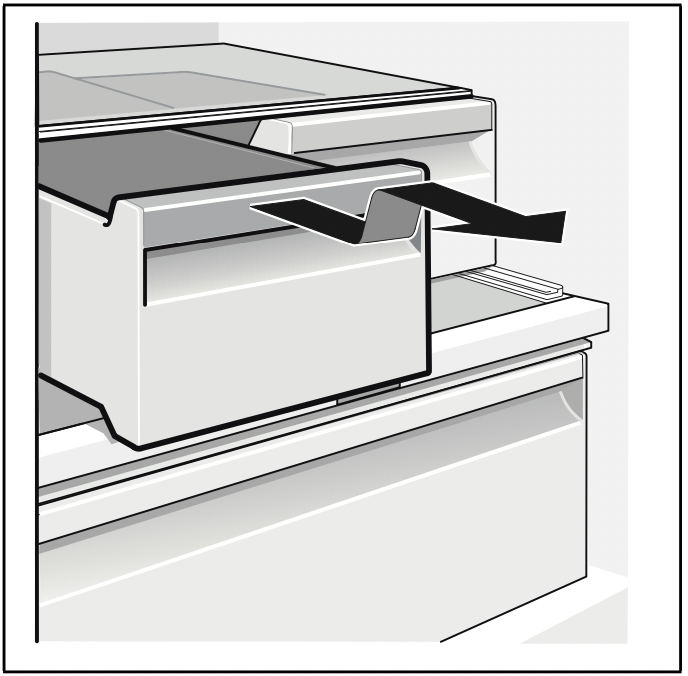
Taking out the frozen food container
Pull out the frozen food container all the way, lift at the front and remove.
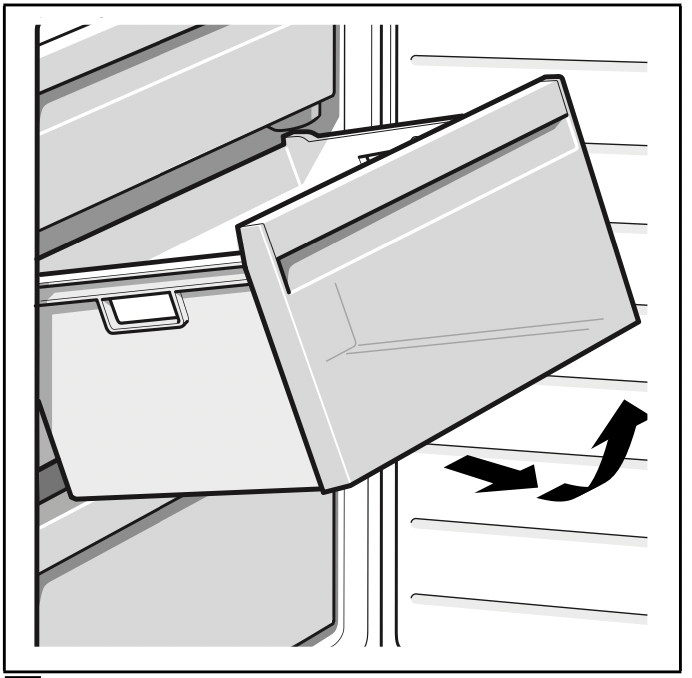
Taking out glass shelf above vegetable container
The glass shelf can be taken out and disassembled for cleaning.
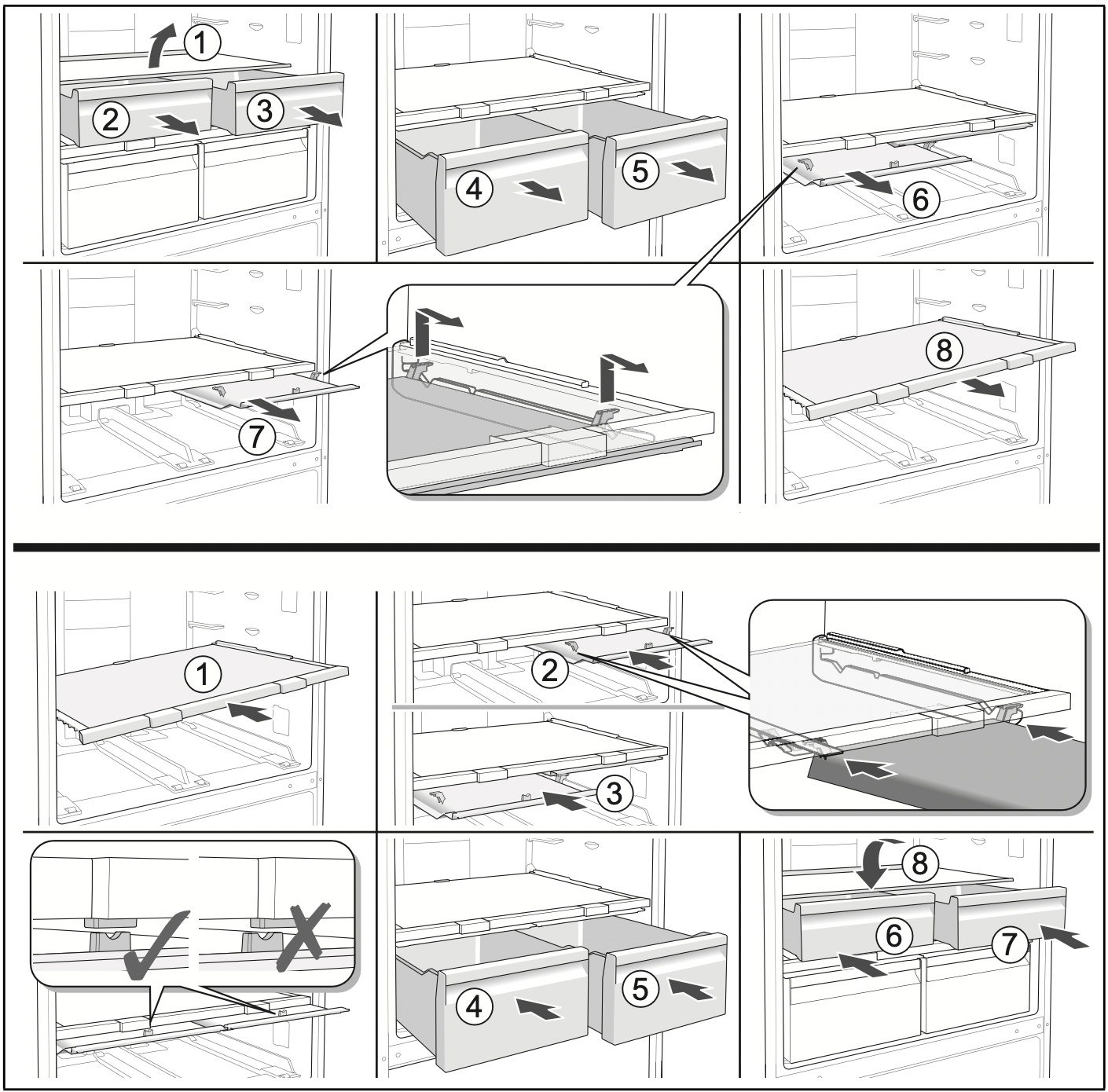
Note: Before taking out the glass shelf, pull out vegetable container.
Light (LED)
Your appliance features a maintenancefree LED light.
These lights may be repaired by customer service or authorised technicians only.
Tips for saving energy
- Install the appliance in a dry, well ventilated room! The appliance should not be installed in direct sunlight or near a heat source (e.g. radiator, cooker).
If required, use an insulating plate. - Allow warm food and drinks to cool down before placing in the appliance.
- Thaw frozen food in the refrigerator compartment and use the low temperature of the frozen food to cool refrigerated food.
- Open the appliance as briefly as possible.
- To achieve the lowest energy consumption, leave a small wall gap at the side.
- The arrangement of the fittings does not affect the energy rating of the appliance.
Operating noises
Quite normal noises
Note: When super freezing is switched on, increased operating noises may occur.
Droning
Motors are running (e.g. refrigerating units, fan).
Bubbling, humming or gurgling noises
Refrigerant is flowing through the tubing.
Clicking
Motor, switches or solenoid valves are switching on/off.
Cracking
Automatic defrosting is running.
Preventing noises
The appliance is not level
Please align the appliance with a spirit level. Use the height-adjustable feet or place packing underneath them.
The appliance is not free-standing
Please move the appliance away from adjacent units or appliances.
Containers or storage areas wobble or stick
Please check the removable parts and re-insert them correctly if required.
Bottles or receptacles are touching each other
Move the bottles or receptacles slightly away from each other.
Eliminating minor faults yourself
Before you call customer service:
Please check whether you can eliminate the fault yourself based on the following information.
Customer service will charge you for advice – even if the appliance is still under guarantee!
| Fault | Possible cause |
Remedial action |
|---|---|---|
| Temperature differs greatly from the set value. |
In some cases it is adequate to switch off the appliance for 5 minutes. If the temperature is too high wait a few hours and check whether the temperature has approached the set value. If the temperature is too low check the temperature again the next day. |
|
| It is too cold in the refrigerator section or in the chill compartment. |
Increase the temperature in the refrigerator section. |
|
|
Push temperature controller for the chill compartment downwards.
|
||
| The temperature in the freezer section is too warm. |
Appliance opened frequently. |
Do not open the appliance unnecessarily. |
|
The ventilation openings have been covered. |
Remove obstructions. |
|
|
Large quantities of fresh food are being frozen. |
Do not exceed the freezing capacity. |
|
| Appliance is not cooling, temperature display and light are lit. | Showroom mode is switched on. |
Press and hold °C button and + setting button for 5 seconds until an acknowledgement signal sounds. Another acknowledgement signal sounds when the buttons are released. After a short time check whether your appliance is cooling. |
| The side panels of the appliance are warm. | Pipes run into the side panels which heat during the cooling process. |
That is normal behaviour for the appliance and not a fault. Furniture touching the appliance will not be damaged by the heat. |
| The light does not function. | The LED light is defective. |
See chapter “Light (LED)” section. |
|
Appliance was open too long. Light is switched off after approx. 10 min. |
When the appliance is closed and opened, the light is on again. |
|
| Displays do not illuminate. |
Power failure; the fuse has been switched off; the mains plug has not been inserted properly. |
Connect mains plug. Check whether the power is on, check the fuses. |
| Freezer compartment door was open for a long time; temperature is no longer reached. | The evaporator (refrigeration generator) in the NoFrost system is covered in thick ice and can no longer be defrosted fully automatically. |
To defrost the evaporator, remove the frozen food with the compartments, insulate well and store in a cool location. Switch off the appliance and move it away from the wall. Leave the appliance door open. After approx. 20 min. the condensation begins to run into the evaporation pan, at the rear of the appliance. To prevent the evaporation pan from overflowing in this case, mop up the condensation with a sponge. The evaporator is defrosted when the water stops running into the evaporation pan. Clean the interior. Switch the appliance back on again. |
|
The following settings are switched off:
The background illumination of the display panel is reduced. Buttons are locked. |
Sabbath mode is switched on. | Press super button for 15 seconds. |
| Condensation accumulates on the surface of the appliance and on the shelves inside. | The effect is reinforced if ambient temperatures are warm and humid. |
Wipe away the water with a soft, dry cloth.
|
